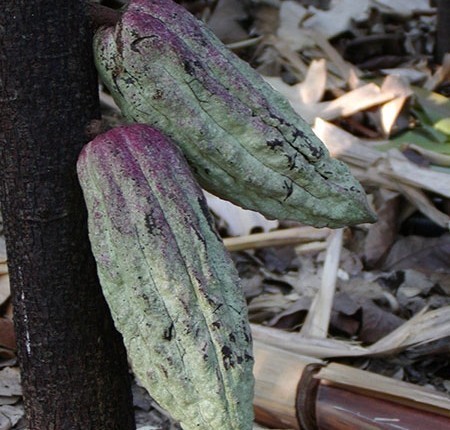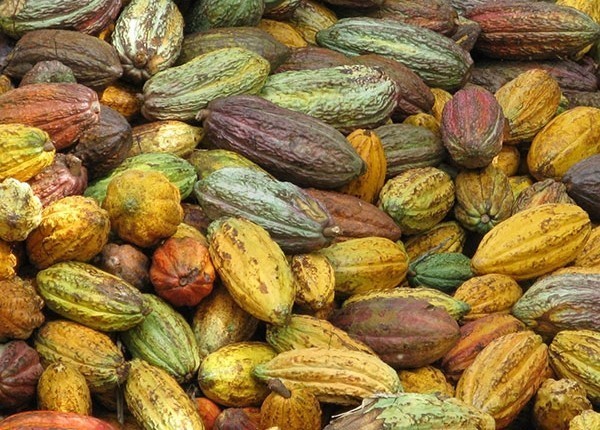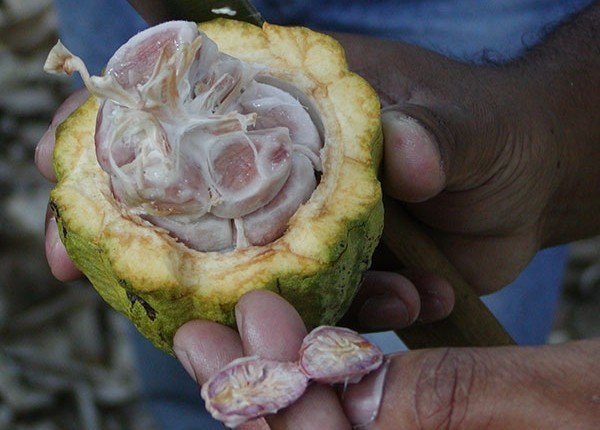What is Fine Flavour Cocoa?
The world cocoa market distinguishes between two broad categories of cocoa beans: “fine flavour” cocoa beans, and “bulk” or “ordinary” cocoa beans. As a generalization, fine flavour cocoa beans are produced from Criollo or Trinitario cocoa tree varieties, while bulk (or ordinary) cocoa beans come from Forastero trees. There are, however, known exceptions to this generalization. Nacional trees in Ecuador, considered to be Forastero type trees, produce fine flavour cocoa. On the other hand, cocoa beans from Cameroon, produced by Trinitario type trees and whose cocoa powder has a distinct and sought after red colour, have, so far, been classified as bulk cocoa beans. It should be noted that the difference between fine flavour cocoa and bulk cocoa is in the flavour rather than in the other quality factors. Fine flavours include fruit (fresh and browned, mature fruits), floral, herbal, and wood notes, nut and caramelic notes as well as rich and balanced chocolate bases.
However, the definition of fine flavour cocoa remains controversial as there is no single universally-accepted criterion that could be adopted as a basis for determining whether or not cocoa of a given origin is to be classified as fine flavour cocoa. Usually, a combination of criteria is used to assess the quality of fine flavour cocoa. These include the genetic origin of planting material, morphological characteristics of the plant, flavour characteristics of the cocoa beans produced, chemical characteristics of the cocoa beans, degree of fermentation, drying, acidity, off-flavours, percentage of internal mould, insect infestation and percentage of impurities. Points are awarded or subtracted by the quality assessors, depending on the condition of the cocoa beans in relation to the above criteria. However, the measurement of some of these criteria is subjective and does not establish objectively that the cocoa in question has the characteristics of fine or flavour cocoa.
In order to fill this gap, a new definition of fine flavor cocoa is stipulated in Article 2.2. of the International Cocoa Agreement 2010 (Ammended): Fine flavour cocoa is cocoa characterized by a complex sensory profile, composed of well-balanced basic attributes with aromatic and flavour notes; the complementary attributes can be clearly perceived and identified in the expression of its aromas and flavours; it results from the interaction between (a) a particular genetic composition, (b) favourable growing conditions in a given environment/terroir, (c) specific plantation management techniques, (d) specific harvesting and post-harvest practices and (e) stable chemical and physical composition, and integrity of the bean.
Characteristics of the Fine Flavour cocoa market
The share of fine flavour cocoa in the total world exports of cocoa beans is relatively small and currently estimated to about 12%. Latin America is the main fine flavour cocoa exporting region, accounting for 90% of the world fine flavour cocoa exports. Ecuador, the Dominican Republic and Peru are currently the three main fine flavour cocoa exporters in term of volumes.
The decline in consumption of fine flavour cocoa over recent decades was brought about by a general shift in consumer demand away from solid products towards filled products, containing other ingredients endowed with stronger flavours (such as nuts, fruits, cream, etc), thus reducing the dependence on the aromatic and flavour characteristics of fine flavour cocoa. Nowadays, chocolate manufacturers use fine flavour cocoa beans in traditional recipes, mainly for a limited number of relatively expensive, up-market finished products. Only very recently has the demand for fine flavour cocoa started to grow very rapidly.
The traditional cocoa consuming countries of Western Europe (Belgium, France, Germany, Italy, Switzerland and the United Kingdom) as well as Japan are the main consumer markets for fine flavour cocoa, while the United States of America uses this type of cocoa to a lesser extent. Some countries in Latin America also have a large domestic market for the use of fine flavour cocoa, as Colombia, Brazil or Mexico for example.
How the Fine Flavour market works
Compared to the international market for bulk cocoa, the market for fine flavour cocoa is generally regarded as a relatively small, highly-specialized and separate market, with its own supply and demand characteristics. Specialist agents buy directly from fine flavour origins for specific chocolate companies. The price received is determined by the supply-demand balance for that particular origin and type of cocoa, with the quality and flavour requirements of the consumer being the primary considerations. Short-term factors influence the offers and bids in this small market with few participants, and hence the price obtained is highly variable. Nevertheless, fine flavour cocoa normally commands a premium over the price on the London and New York cocoa futures markets.
However, there are indications that in the nineties and in the major part of the past decade, the levels of premiums for fine flavour cocoa had generally declined. This phenomenon resulted partly from the widespread concern among users of fine flavour cocoa about the reliability of future supplies, both in terms of quantity and quality. Indeed, to enable a chocolate manufacturer to plan for the continued inclusion of a particular type of cocoa in his recipe, he must be assured of a regular supply of that particular cocoa, in the quantities and quality he requires. In addition, progress made in the manufacture of chocolate allowed companies to maintain or improve the taste of chocolate products despite lower quality and flavour of the cocoa beans. The resulting lower demand for fine flavour cocoa beans as well as the mixing of fine flavour cocoa beans with bulk cocoa beans led to declining price premiums for this type of cocoa.
The recent increasing demand for high quality chocolate gave the fine flavour cocoa market a new lease of life. Indeed, most major chocolate manufacturers have included premium quality chocolate products in their range. These require fine flavour cocoa from specific origins in their recipes, in order to achieve the required distinctive taste or colour of the chocolate. Many new chocolate artisans are emerging as well, bringing more demand for this cocoa type. The growing success for fine flavour cocoa has a direct positive impact on the sustainability of the farming cocoa sector through significantly higher farm gate price paid to the producer. It could be noted that the development of fine flavour cocoa market is closely linked to the emergence of new consumer trend to organic cocoa and beans-to bar.
The ICCO Ad Hoc Panel on Fine Flavour Cocoa
History of the Panel
The share of fine flavour cocoa in the production of cocoa beans of individual countries has developed over time. Successive International Cocoa Agreements recognized producing countries exporting either exclusively or partially fine flavour cocoa. The list of countries and their proportion of production of fine flavour cocoa under the successive International Cocoa Agreements of 1972, 1975, 1980, 1986, 1993 and 2001 and 2010 are reproduced in Annex C of each Agreement.
Article 39 of the International Cocoa Agreement (ICA), 2010 stipulates that “the Council shall, at its first session following the entry into force of this Agreement, review Annex C of this Agreement and, if necessary, revise it determining the proportion in which the countries listed therein produce and export exclusively of partially fine flavour cocoa. Thereafter, the Council may at any time during the lifetime of this Agreement review annex C and, if necessary, revise it. The Council shall seek expert advice on this matter, as appropriate. In such cases, the composition of the Panel of Experts, should, as far as possible, ensure a balance between experts from importing countries and experts from exporting countries. The Council shall decide on the composition of and on the producers to be followed by the Panel of Experts.”
Objective of the Panel
The overall objective of the ICCO Ad hoc Panel on Fine Flavour cocoa is to provide reference to key players in the cocoa economy of the percentage of fine flavour cocoa exported by cocoa producing countries.
Meanwhile, objective, affordable, and practical verifiable indicators discriminating bulk cocoa beans from fine flavour ones do not exist. But it is possible to gain some insights on the temporal evolution on the exports of fine flavour cocoa beans from a given exporting country indirectly from international trade statistics (with a focus on volume, prices and destination of exports) and from technical information regarding national cocoa sector.
The deliberation to establish the percentage of exports is undertaken by a group of independent experts with ample experience in trade, processing, manufacturing and testing of fine flavour cocoa. These independent experts are selected by the ICCO and provide their views and experiences based on each country case.
In order to guide the experts during the deliberation process, all cocoa-producing countries wishing to be assessed for inclusion in the list of countries exporting fully or partially Fine flavour, should provide, prior to each meeting of the Ad-Hoc Panel, a technical information dossier. This dossier covers a broad range of information regarding country’s cocoa sector as among other things, cocoa history/heritage, international awards received, genetics of cocoa, cocoa processing and marketing, etc. The template of the technical information dossier is provided below.
Once deliberations have taken place, the Panel submits its recommendations to the International Cocoa Council (the supreme body of the ICCO) for its approval and adoption.
Who are the Fine Flavour cocoa exporting countries?
The list of Fine Flavour cocoa exporting countries was successively revised by the Ad Hoc Panel on Fine Flavour cocoa in 2004, 2008, 2010, 2015 and 2019.
In June 2023, in Antananarivo, Madagascar, the Ad-hoc Panel on Fine Flavour cocoa provided its recommendations for the revision of Annex C of the ICA, 2010.
An updated list of Fine Flavour cocoa exporting countries was amended by the 109th Ordinary Session of the International Cocoa Council in April 2024, as detailed below.
ANNEX “C” OF THE INTERNATIONAL COCOA AGREEMENT, 2010
PRODUCING COUNTRIES EXPORTING EITHER EXCLUSIVELY OR PARTIALLY FINE OR FLAVOUR COCOA
(Fine or Flavour cocoa beans as a percentage of total cocoa bean exports of the country)
| Countries | Council decision April 2024 |
| Brazil | 100% |
| Cameroun | a/ |
| Colombia | 80% |
| Costa Rica | 100% |
| Dominican Republic | 60% |
| Ecuador | 75% |
| El Salvador | 100% |
| Ghana | a/ |
| Grenada | 100% |
| Haiti | 10% |
Notes:
a/ Fine or Flavour cocoa bean exports are present, but the Panel is not able at this time to evaluate and determine a percentage.
| Countries | Council decision April 2024 |
| Indonesia | 10% |
| Jamaica | 100% |
| Madagascar | 100% |
| Malaysia | a/ |
| Nicaragua | 80% |
| Papua New Guinea | 80% |
| Peru | 75% |
| Trinidad and Tobago | 100% |
| Venezuela, Bolivarian Rep. of | a/ |
| Vietnam | 80% |
Reports of the meetings of the ICCO Ad hoc Panel on Fine or Flavour cocoa
Announcements and events related to Fine or Flavour Cocoa
ED(MEM) 1245 – Revision of Annex C of ICA 2010 – English
ED(MEM) 1222 – Revised Annex C October 2023 – English
ED(MEM) 1205 – Edition 2023 Ad Hoc Panel Madagascar – English
ED(MEM) 1200-Rev.1 – Meeting Logistics FF Panel 13-14 June 2023 Antananarivo (Madagascar) – English
ED(MEM) 1145 -Revision of Annex C of the ICA 2010 English
ED(MEM) 1080-Rev.1 – Meeting of the Fine Flavour Ad Hoc Panel 12-13 April 2019
ED(MEM) 1079-Rev.1 – Meeting Logistics FF Panel 12-13 April 2019



